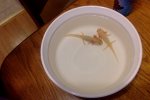The cycling process can take from 3-6 weeks. For your tank to be cycled, a beneficial bacteria needs to be present to break down the Ammonia and Nitrites into Nitrates. Ammonia and Nitrites are lethal to Axolotl and are produced from your Axolotls waste (or other ammonia sources) and decomposing food. Nitrates are a less toxic by product. During cycling the beneficial bacteria will colonize your tanks surfaces such as substrate, ornaments, filter, and begin to feed on the Ammonia turning it into Nitrites, then bacteria will break down the Nitrites into Nitrates. The bacteria is known as a biofilter, as it filters the ammonia and nitrites into less harmful nitrates.
You will need to start seeing Nitrites to know your cycle is about half way through, then NirAtes to know that your cycle has reached the final stage.
-You will see a rise of each toxin in this order: Ammonia will appear once produced from the Axolotl waste, this will then convert into Nitrites, and then the final out come is the conversion to NitrAtes you should eventually be left with 0 Ammonia 0 Nitrites and around 40< ppm of Nitrates which you can lower by doing 30-40% water changes.
Buy this liquid test kit:
http://www.amazon.com/API-Freshwater-Master-Test-Kit/dp/B000255NCI
Test your Ammonia, Nitrite, Nitrates, and PH.
In the meantime put your Axolotl in a separate tub/container and change the water 100% daily with dechlorinated water, this makes sure your Axolotl isn't exposed to any of the toxin's that may be in your tank as it cycles.
If you get the test kit, provide a source of Ammonia and check your water for Ammonia, Nitrite, Nitrates daily, you can follow your cycle until you know it is complete. Don't rely on the pet shop for anything.
If you haven't got to grips with how cycling works you should read these articles as well as the article Skudo shared with you.
Caudata Culture Articles - Water Quality
Caudata Culture Articles - Cycling
You must make it top priority to understand the Nitrogen (cycling) process, as well as basic care such as dechlorinating water, temperatures and housing, its vital to provide the best living conditions for your Axolotl.
Dechlorinator must be added to water before you put it in your tank, so when you fill up your buckets/containers of water add the dechlorinator to the bucket and then add the water, this allows the water to be properly dechlorinated and the metal toxins to be neutralized before you add the water to the tank.
Read these articles too:
Axolotls - Requirements & Water Conditions in Captivity
If there's anything your not 100% sure about, just ask!


